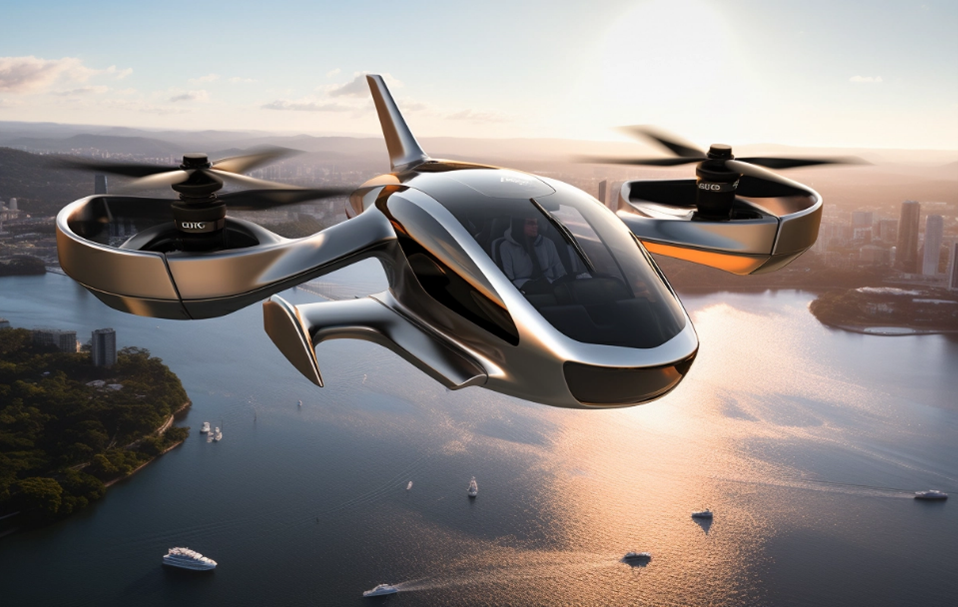How AI can fast track the developments our aviation sector desperately needs

Aircraft concepts have been conceived in unison with Midjourney AI. Image credit: Thomas Luke
In summary
With the help of artificial intelligence, new aircraft designs that meet modern demands could be a reality as soon as 2025
Thomas Luke, PhD candidate at Swinburne University of Technology’s Aerostructures Innovation Research (AIR) Hub is investigating how AI can be used in the design phase of an aeroplane
GenAI has the potential to address existing issues within the aviation sector like safety and provide insight on how the industry can improve
The aviation industry has been plagued with issues post-pandemic, from recent airline safety concerns to mass holiday delays and cancellations.
But, with the help of artificial intelligence, new aircraft designs that meet modern demands could be a reality as soon as 2025 and help alleviate these concerns.
Thomas Luke, PhD candidate at Swinburne University of Technology’s Aerostructures Innovation Research (AIR) Hub, says that AI should be a crucial consideration in the industry’s transformation and could help Australia become a global aviation leader.

PhD student Thomas Luke presents his ideas on radical design-driven innovation
“We're on the precipice of a big transition, with new modes of transport to be used by 2025. AI can radically innovate this space and allows Australia to fast-track projects in the aerospace sector.”
Thomas is investigating how AI can be used in the design phase of an aeroplane using a text-to-image generator and has developed new concepts that could be adapted by industry to make innovative new aeroplanes.
Traditional illustration and concept renderings can take days and valuable resources to produce. Thomas’ designs are created within 20 seconds.
“This new horizon of aerospace demands a different approach,” he says. “Small aeroplanes are super functional and are achievable to fast track into the industry for public use.”

Aircraft concepts designed with the help of AI. Image Credit: Thomas Luke
The future of aviation
With the help of emergent AI, Advanced Air Mobility (AAM) offers a glimpse into the future of electric vertical takeoff and landing (eVTOLs) vehicles that are expected to play a pivotal role in the future of aviation.
“AAM represents a significant evolution in aviation,” says Thomas. “It envisions the future of air transportation, embracing modern technologies, materials, processes, user experience and innovative thinking to solve complex problems. AAM and its unique air vehicles will encounter new challenges; this makes it an opportune moment to weave AI into the fabric of this emerging industry from the ground up.”
GenAI has the potential to address existing issues within the aviation sector. It helps tackle pressing matters like safety and provides insights into how the industry can evolve and improve.
Thomas says GenAI serves as an invaluable 'co-author’, empowering professionals to enhance their work. “This allows for re-examining existing challenges with fresh perspectives and tackling new tasks more innovatively than traditional approaches,” he explains.
Though the aviation sector’s complexity cannot be understated, he hopes that AI can ease the load among a struggling industry.
“AI tools offers a vision of the future where exploring a broader range of solutions becomes more efficient and accelerates our progress so that Australia becomes an aviation leader worldwide.”
-
Media Enquiries
Related articles
-

- Astronomy
- Technology
- Science
- Engineering
Meet Swinburne’s Roo-ver Mission team
Roo-ver will be Australia's first lunar rover, and it’s being designed, built and tested in Australia. Swinburne is playing a key role in the design and construction of Roo-ver, through its involvement in the ELO2 Consortium.
Wednesday 26 November 2025 -

- Technology
- Health
- Science
- University
- Aviation
- Engineering
Swinburne’s Mobile Innovation Lab hits the road
Swinburne’s Mobile Innovation Lab is a cutting-edge mobile facility designed for research, industry collaboration, STEM education, training and outreach.
Thursday 06 November 2025 -

- Astronomy
- Technology
- Science
- Aviation
- Engineering
Shaping space innovation at the International Astronautical Congress
The 76th International Astronautical Congress (IAC) united over 7,000 delegates from more than 90 countries to explore the future of space. Swinburne staff and students delivered 20 talks, panels and presentations, showcasing Australia’s growing leadership in research and education.
Friday 10 October 2025 -

- Engineering
- Technology
- Aviation
Swinburne contributes to $270.5m Australian manufacturing research initiative
The Additive Manufacturing Cooperative Research Centre (AMCRC) seeks to transform Australia's healthcare, aerospace, and construction sectors.
Monday 28 April 2025 -

- Aviation
- Sustainability
- Engineering
Australian-made sustainable powders to drive the future of advanced manufacturing
A high-tech spinout from Swinburne University of Technology will deliver Australian-made High Entropy Material (HEM) powders, developed from recycled industrial feedstocks, to advanced manufacturing and 3D printing facilities.
Thursday 27 March 2025

